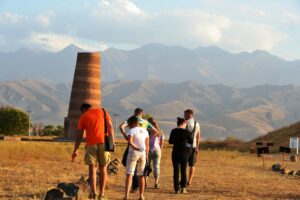The term “the Great Silk Road” was introduced into the historical science by the 19th century scientists after the German traveler and historian K. Richthofen wrote his work “China” in 1877 in which he defined this trade route through the Eastern countries for the first time as the “Silk Road”.
It is known that the Chinese emperor By Di in 138 BC sent his ambassador Zhang Qian to search for allies in the fight against the militant nomadic tribes of the Huns, who were devastating the northern outskirts of China. Traveling, the ambassador was captured by the Huns for ten whole years. He managed to escape and through the high passes of the Central Tien Shan to reach Issyk-Kul. After traveling along the banks of the Naryn River, he found himself in the Fergana Valley. It came as a surprise to him that there were many cities in the valley, all united into one state. He tried to negotiate with the ruler of the Fergana Valley, but he only agreed to establish trade relations, and Zhang Qian left further to the south. Returning from a trip, he again fell captive to the Huns, but this time escaped after two years. Zhang Qian submitted to the emperor a detailed report on his stay in Central Asia, indicated convenient routes for trade, which later became the basis of the Great Silk Road. The emperor gave him the title of “Great Traveller.
Records of exchanges between China and Central Asia are mostly found in Chinese chronicles from the 1st century B.C. to the 7th-8th centuries A.D. The earliest accounts tell of gifts that were sent from Central Asian countries to the imperial palace. The Chinese also sent gifts from here, if China wanted to attract any of the local rulers to its side. Among the gifts from Central Asia, the famous Davani horses, fast-moving racers that the Chinese called “heavenly” or “winged” were especially valued. They were valued because there was a legend in China that in order to affirm his divinity and achieve immortality, the emperor had to ascend to heaven with the help of the harness of unearthly horses. It was Zhang Qian who brought the “heavenly” horses to China. This enterprising traveler brought not only horses from Central Asia but also alfalfa seeds as food for them. Soon alfalfa crops spread throughout China.
Gradually, trade relations between Central Asia and China strengthened. Every year the imperial court sent at least five missions to the west, accompanied by several hundred guards. They carried silk and metal goods, which were exchanged for horses, jade, coral, and other goods from Central Asia. Chinese wares were not just for Central Asia. There was a significant need for unique silk fabrics in Persia and in the states to the west of it.
Caravans, which left China, headed for the northern Tien Shan mountains, crossed the territory of Central Asia, and then through Khorasan (west of the Amu Darya) reached Mesopotamia and the Mediterranean Sea.
According to different data, the length of the Silk Road was from 7,000 to 12,000 kilometers, so few traders passed the entire silk road. Basically, they tried to travel in shifts and exchange goods somewhere halfway.
Being a conventional name, the Great Silk Road was a network of roads, which in antiquity and the Middle Ages carried out trade and economic relations of the East and West, located between the then world civilizations – the Roman (Byzantine) and Han (Chinese) empires.
At the boundary of the ancient and modern eras, trade caravans from China started from Changyang and went to Dukhua, a city on the border of the Great Wall. From here, the route diverged into two paths: the northern and the southern.
“The northern route went along the southern slopes of Tien Shan and the river Tarim through Turfan and led to Kashgar, Alai, and from there – to the Fergana Valley (Davan), Central Asian Mesopotamia (Samarkand, Mera), then turned to the lower reaches of the Volga and the Northern Black Sea coast (in the Chinese sources – Lissian).
Baitik Baatyr
Baityk (Baitik) Kanayev (1820-1886) was a hereditary manap of the Solto family in the Chui




